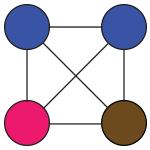Published/Posted: July 1, 2016
Authors: Hart, J. D.; Bansal, K.; Murphy, T. E.; Roy, R.
DOI: 10.1063/1.4953662
Abstract: A “chimera state” is a dynamical pattern that occurs in a network of coupled identical oscillators when the symmetry of the oscillator population is broken into synchronous and asynchronous parts. We report the experimental observation of chimera and cluster states in a network of four globally coupled chaotic opto-electronic oscillators. This is the minimal network that can support chimera states, and our study provides new insight into the fundamental mechanisms underlying their formation. We use a unified approach to determine the stability of all the observed partially synchronous patterns, highlighting the close relationship between chimera and cluster states as belonging to the broader phenomenon of partial synchronization. Our approach is general in terms of network size and connectivity. We also find that chimera states often appear in regions of multistability between global, cluster, and desynchronized states.Citation:
J. D. Hart, K. Bansal, T. E. Murphy and R. Roy, "Experimental observation of chimera and cluster states in a minimal globally coupled network", Chaos 26(9) 094801 (2016)
Export: BibTeX | RIS
Manuscript: Hart_Chaos_26_094801_2016.pdf
